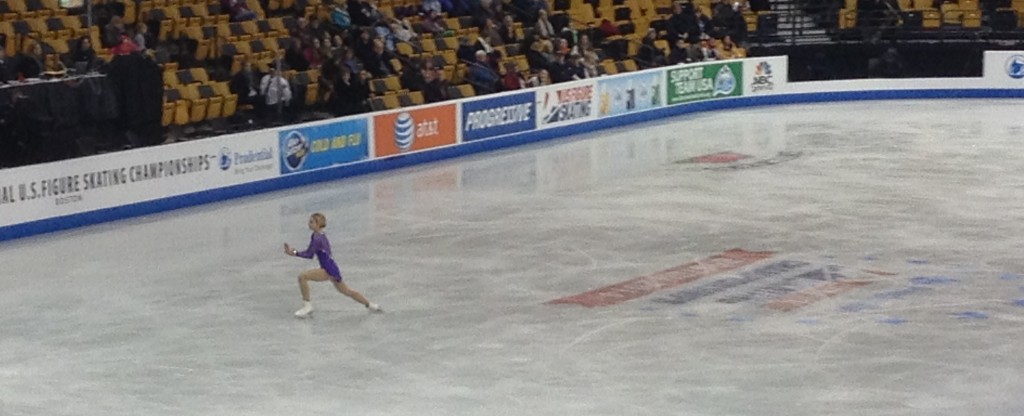Every person who ever considers a career in sports media has those moments that steer them down that path. I talk often about the one that sent me full steam ahead in that direction – Super Bowl XXIX, with Steve Young finally lifting “the monkey off his back” and leading the San Francisco 49ers to their fifth Super Bowl win – but there was a moment three years prior that made me take the initial step.
It was February 1992. Ten year old me was deep in the throws of the 1992 Winter Olympics in Albertville, France. It was that wonderful first Saturday of February school vacation, day one of my being able to watch as much of the Olympics as I could find without school, dance or Girl Scouts getting in the way.
I was over at my aunt’s split level ranch in East Irondequoit, NY, walking through the kitchen when I caught the 6pm news sports report on her tiny TV in the corner.
“A major shocker in the men’s figure skating tonight,” said the anchor. “If you don’t want to be spoiled, turn away from the TV now.” A way of life of an Olympic obsessed child in the pre-internet age, I would cover my eyes in an effort to convince others I wasn’t watching the TV flash the results, but spread my fingers apart on my right hand so I could see the screen.
Through the fingers on my right hand, I saw that Paul Wylie had won the silver medal. I broke rule #1: I admitted I saw the results. “MOM! The U.S. won the silver medal!”
“Don’t spoil us!” someone yelled.
“Which one?” my mom asked.
“Paul Wylie!” I exclaimed.
“Who?” my aunt asked.
“The third guy!” I explained.
“The third guy?” my mom said in amazement. “He wasn’t even supposed to be on the team!”
Later that night, we gathered around my aunt’s TV in the den and watched Wylie’s long program earn him an Olympic silver medal. Scott Hamilton commentated, and during the wait for Wylie’s scores, he deemed the performance “one of the biggest surprises in figure skating history.”
Wylie had skated on the senior level since the early 1980s. After winning the World Junior title in 1981, he placed fifth four times on the senior level until leaping to second in 1988 and making the 1988 Olympic team. In Calgary, he finished tenth. He earned the journeyman moniker soon after, making three World Championships and finishing 9th, 10th and 11th, all while attending Harvard.
As the 1992 Olympics neared and younger skaters (like Todd Eldredge, who would turn out really defining the term journeyman) began to threaten, Wylie seemed to be the odd man out for a second Olympic team. He finished second at Nationals that year and made the team by placement, but critics called for him to be booted for the younger Mark Mitchell or for reigning World bronze medalist Eldredge, who was petitioning onto the team after being unable to compete at Nationals.
Wylie, Eldredge and Christopher Bowman (a two-time World medalist) ended up making the U.S. squad in Albertville’s men’s figure skating event. Of the three, Bowman and Eldredge looked to be the medal contenders, and Wylie was largely forgotten about. He was so disregarded that he was preliminarily left off the post-Olympics World Championships team in the place of Mitchell.
And then Wylie finished third in the Olympic original (now called short) program. Bowman was seventh, Eldredge ninth.
Wylie skated second to last in the long program and delivered a fantastic performance that had the audience on their feet. He turned out of two jumps, but otherwise skated cleanly and with better spins and edge work than the skater immediately preceding him, the Unified Team’s Viktor Petrenko. The judges marks for Wylie varied greatly, with the Czech judge handing him marks only good enough for fifth and the Unified judge placing him fourth. The remainder of the judging panel had Wylie on the medal stand. Petr Barna, the last skater in the competition, represented Czechoslovakia, and it was clear that his home country’s judge was saving room to keep him on the medal stand by scoring Wylie extremely low.
Political shimmying may have torpedoed some of Wylie’s marks, but at the end of the night of February 15, 1992, he won the silver medal, a shocking finish to an Olympics some within the U.S. skating community didn’t think he should compete at.
Watching the entire story unfold on CBS’ Olympic coverage that evening had young me enamored, and it was one of the first times I thought, “There are people who get to tell about this amazing story. Wouldn’t it be neat to be one of them?”
Twenty-three years later, Wylie’s Olympic story is largely forgotten by the general public, which is a shame. As news broke Wednesday that the now 50 year old Wylie had been hospitalized with a heart issue, those in figure skating shared on social media how impactful his ’92 performance and career has been. The incredible Wylie story has been grossly underrated over the past two decades, and it’s time again to remind the general sports community of one of the most remarkable U.S. Olympic moments of the last fifty years.
